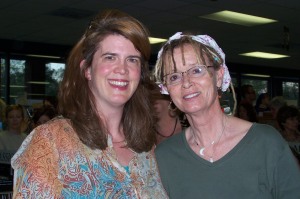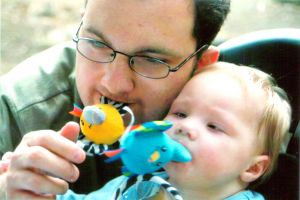
Just after my daughter’s second birthday, she had a prescription to get blood drawn. I told myself it would be okay and I decided that it would be easier for her if she watched me do it first.
We went to the local hospital. I had gone there many, many times during the past year for blood counts as I had been receiving treatment for cancer. A treatment that left me so weak, I was unable to pick her up for most of that past year.
The technicians greeted us.
“This is my daughter Kaylee.” I turn to the side so they could see her, perched on my back in the Mei Tai. It was only a few months since treatment ended, and it was the first time I had worn her in over a year.
“I had no idea you had a daughter! She is so beautiful. Its so nice to meet her.” With each sentence the tech’s voice became more melancholy. As if she were connecting the memories of seeing me ill to the new knowledge that I had a young child.
“She needs to get blood taken. Is my perscription still on file? I think it will be easier for her if she sees me do it first.”
“Its not going to work. Every toddler needs to be held down.”
“I still want to try.” I told them and asked them again to check for the prescription. The nurse found it and I sat down in the chair with Kaylee in my lap.
“I’m pulling up my sleeve so they can take blood.” I said as I rolled up my sleeve and placed my arm on the table.
“Now she’s tying a band around my arm. It doesn’t hurt, but it feels kind of funny. Its not very comfortable and sometimes it pinches my skin.” The tech was not amused. I could only assume she thought that by validating any fear, I would be instilling greater resistance. And nobody wants to hold down a toddler to take blood.
“Next she is going to put a needle in my arm. I am a little nervous because it sometimes hurts.”
“Don’t be nervous.” Kids aren’t the only ones who are told “no” to their emotions.
“Its okay to be nervous.” I tell both the tech and Kaylee.
“How could I not be?” I thought to myself, remembering all the times my veins were difficult to find. Remembering how my blood counts would dictate if I could continue treatment on schedule. The fear I had experienced when they were too low to begin a new cycle of chemo, my fate seemed to be resting in the hands of a single missed week of treatment.
“But you are always so calm when you get blood taken.” I was glad to be pulled out of those memories and back into the room.
Back to that moment. To my daughter.
“I am nervous, you just can’t see it.”
The needle went into my arm with ease.
“Now we can watch the blood.” I said, relieved.
The nurse untied the band and removed the needle.
“Now they are going to wrap up my arm, so I don’t get a bruise.”
“And that’s it. Are you ready?”
She shook her head no.
“You need a minute?”
She nodded.
“You can do this.” I told her with certainty.
She rolled up her sleeve. One of the nurses held her hand to keep her arm still and the other began the process.
I talked her through the steps just as I had done moments before.
I held her tight.
So very tight.
“I am here. Mommy’s here.” I repeated in her ear, over and over.
Just saying those words were empowering. I had been away for much of that past year.
A part of me was fearful in these words, scared cancer could return and take me away again. And I was grateful Kaylee wasn’t wondering the same thing.
I could see her bottom lip puffed out in a frown. Her mouth was quivering. There was no fighting or screams, though she was clearly upset.
“She is so sad. She’s going to make me cry.” Tears filled the tech’s eyes.
When it was completed, we were all amazed.
Amazed at the courage and strength of my little girl.
And so very thankful.
To have been able to tell her “mommy’s here.”
To have had the strength to wear her that day.
To have had the tools to help her through this challenge.
That she had felt safe and confident in her emotions. That she expressed herself.
That despite being weaned overnight and separated from me for almost a year, we still had an incredible connection. That all the principles we had practiced since birth had given us the ability to work through the challenges we experienced. That she had every reason to be a bratty toddler and she was anything but.
After that experience, it was so clear that attachment parenting worked. It worked wonders.
Pushing through the resistance and challenges that came along with AP had become a wonderful gift for our family.
And it was a wonderful gift to see the results in action, too.
A few months after this experience, she came with me to a doctor’s visit. She sat on my lap as I had blood drawn.
When it was over, she pulled up her sleeve and wanted a band-aid.







 I cannot underscore the importance of a supportive spouse, partner, or mother’s helper when you’re a work-from-home parent of a mobile baby or preverbal toddler.
I cannot underscore the importance of a supportive spouse, partner, or mother’s helper when you’re a work-from-home parent of a mobile baby or preverbal toddler.
